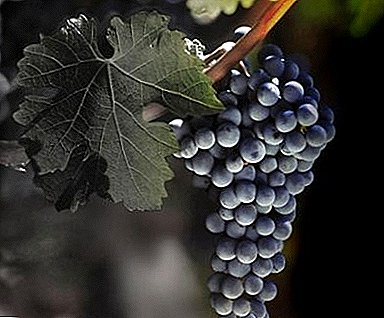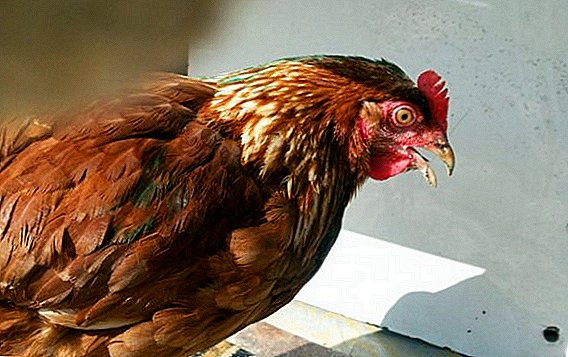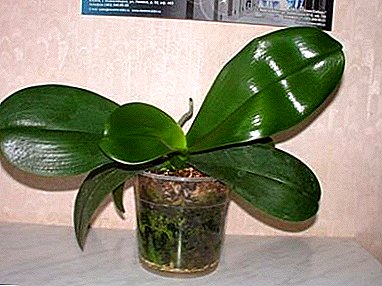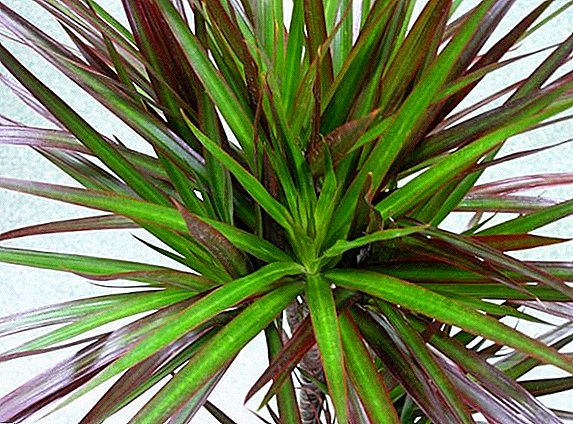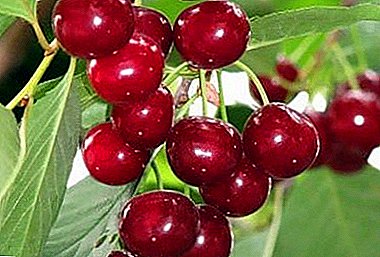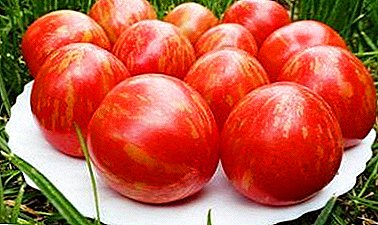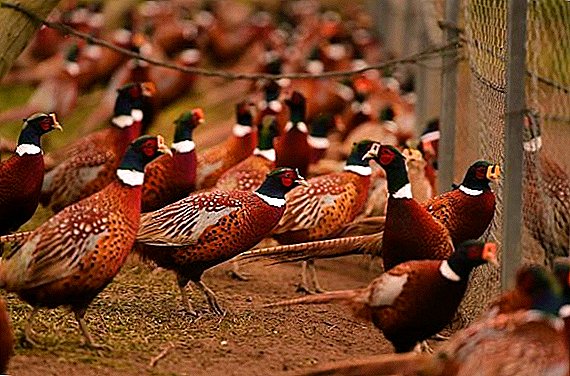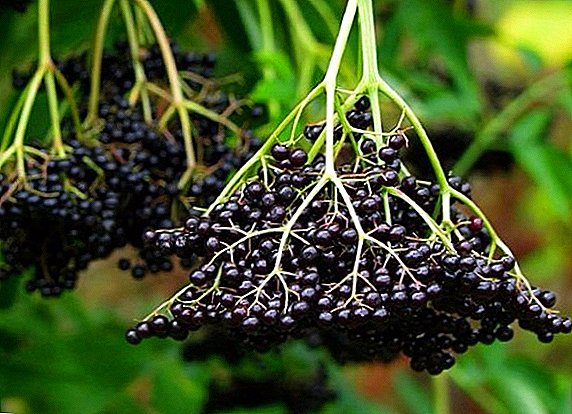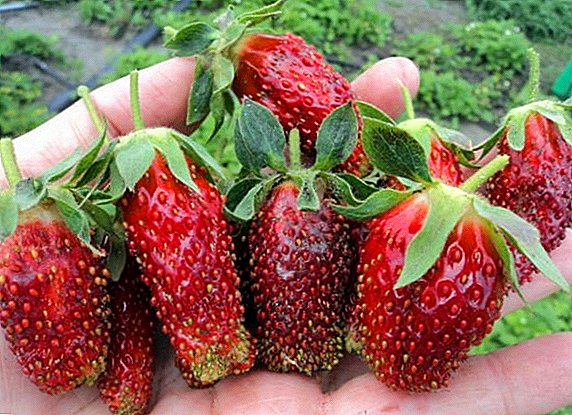 Strawberry is considered to be one of the favorite berries, the first seasonal delicacy that appears on the tables after a long and dull winter. It is not surprising that happy owners of dacha plots must plant at least a small bed of this fragrant sweet berry. The only question is which variety to give preference among the many options. A good choice is a hybrid with the promising title "Merchant". Get to know him better.
Strawberry is considered to be one of the favorite berries, the first seasonal delicacy that appears on the tables after a long and dull winter. It is not surprising that happy owners of dacha plots must plant at least a small bed of this fragrant sweet berry. The only question is which variety to give preference among the many options. A good choice is a hybrid with the promising title "Merchant". Get to know him better.
Variety description
I would like to start with the fact that "Merchant", strictly speaking, is not a strawberry, nor even strawberries. This is a very special berry, which is a hybrid between these two species. "Parents" varieties are musk and wild strawberry, respectively, wild strawberries.
Did you know? The ancient Greeks believed that the first strawberry berries emerged from the tears of Aphrodite, who mourned her dead beloved Adonis.This is a young variety of the second generation, bred in 2014 by S.D. Aitjanova. The patent holders are the Bryansk State Agrarian University and the All-Russian Breeding and Technological Institute of Horticulture and Nursery Farming (VSTISP).
 The plant forms rounded, compact, strong, strong and tall (up to 25 cm) bushes with broad dense leaves of trifoliate concave shape of a rich dark green color. A distinctive feature of the leaves is their strong ribbing and wrinkling, which makes it easy to distinguish a hybrid from a fake.
The plant forms rounded, compact, strong, strong and tall (up to 25 cm) bushes with broad dense leaves of trifoliate concave shape of a rich dark green color. A distinctive feature of the leaves is their strong ribbing and wrinkling, which makes it easy to distinguish a hybrid from a fake.Familiarize yourself with the nuances of growing strawberry varieties such as Bereginya, Florence, Marmalade, Garland, Darselect, Vicoda, Zephyr, Roxana, Tristan, Kama, Alba "," Mara de Bois "," Honey "," Clery "," Finnish "," Maxim "," Queen ".
Leaf petioles are long and well pubescent, villi are a little lowered. Blossoming is very abundant: on average, 15 powerful semi-sprawling peduncles with a dozen of bisexual flowers on each form on a bush. The mustache is dark red.
During its short history, the hybrid managed to catch the fancy of not only summer residents, but also professional farmers who grow it on an industrial scale. Such success is due to the mass merits of the variety. 
In particular, the “Kupchikha” is distinguished by:
- high yield, stable in all weather conditions;
- quite large fruits;
- excellent taste of berries, allowing them to be used in different directions (fresh or for harvesting);
- resistance to the shedding and rotting of berries, even with late collection;
- good crop transportability rates;
- moderate mustache formation (greatly facilitates care of the culture);
- high flower pollinability (reaches 100%);
- high winter hardiness;
- heat resistance;
- resistance to stress;
- complex resistance to most diseases and pests;
- absolute unpretentiousness.
Speaking about the shortcomings, it can be noted that the hybrid is not the largest berries, the breeder failed to achieve complete absence of acid and, moreover, there are varieties that ripen much earlier, and, accordingly, their market value is higher.
Some gardeners prefer to grow bezusye varieties of strawberries, to which the "Merchant" does not apply. "Merchant" refers to non-repair varieties (that is, the crop gives only once a year), which can also be conditionally considered its disadvantage.
Many are looking for answers to such questions as: how to process strawberries in autumn, how to properly care for strawberries during flowering, what siderats need to be planted under strawberries to increase yields, how often to water strawberries, how to feed strawberries correctly in spring.
Characteristics of berries and yield
Berries "Merchants" are of medium size and differ in their characteristic elongated shape, sometimes a bit like a trident. Usually one berry weighs 10-25 g with a length of 3-4 cm, especially large specimens can, however, reach 6-7 in length and have a mass of 50 g  Another distinctive feature of the hybrid is the color of the berries: very dark, ruby, sometimes even purple. At an early stage of ripening, the fruits may have an uneven color and white tips, but as they mature, the color evens out, becoming uniform and saturated.
Another distinctive feature of the hybrid is the color of the berries: very dark, ruby, sometimes even purple. At an early stage of ripening, the fruits may have an uneven color and white tips, but as they mature, the color evens out, becoming uniform and saturated.
The taste of the fruit is harmonious, well-balanced: sweet with spicy sourness and pronounced nutmeg notes, in overripe berries even more saturated. Spicy strawberry flavor is pronounced and lasts long enough. The flesh is firm, elastic, not very juicy, has a dark red color.
Berries contain:
- sugar - 5.8%;
- ascorbic acid - 79%;
- organic acids - 0.6%.
Tasting evaluation of fruits - 5 points on a five-point scale. By the time of ripening, the “Merchant” refers to mid-season varieties, starts to bear fruit from mid-June and later, depending on the region of cultivation.  Speaking about productivity, also it should be noted that it directly depends on growing conditions. "Merchant" is perfectly acclimatized in a variety of climatic conditions (for example, in Russia it can be planted literally everywhere), but the rates of fruiting can vary greatly.
Speaking about productivity, also it should be noted that it directly depends on growing conditions. "Merchant" is perfectly acclimatized in a variety of climatic conditions (for example, in Russia it can be planted literally everywhere), but the rates of fruiting can vary greatly.
The authors declare the yield of the variety at the level of 135 centners per hectare. In practice, it can be about taking 300-310 g of berries from one bush under medium growing conditions and the possibility of increasing the yield to 500 and even 800 g with more professional agricultural techniques.
Important! The general rule is this: with a balanced feeding and moisture, the crop is higher, the higher the average annual temperature indicators in the region.

Agrotechnics of growing and caring for strawberries
Amazing unpretentiousness - the main advantage of the "Merchant". But the better conditions for it will be created, the more it will delight the farmer or summer resident.
Selection of seedlings
At first glance, the choice of hybrid seedlings does not present any particular difficulties, the appearance of the bushes is distinguished by very many characteristic features. And yet there is a nuance - the hybrid is still too young to get widespread.
It is not easy to get it, that is why quite ordinary varieties of strawberry can be sold under the guise of a miracle of Russian selection. The best way to get quality seedlings and not become a victim of fraud is to appeal to the copyright holder.  In Moscow and the Moscow region there will be no problems with this. FSBI VSTISP has a fairly well-developed network of points of sale where you can order quality seedlings. Residents of other regions can only study the external characteristics of the bush "Kupchikh" and rely on their own care.
In Moscow and the Moscow region there will be no problems with this. FSBI VSTISP has a fairly well-developed network of points of sale where you can order quality seedlings. Residents of other regions can only study the external characteristics of the bush "Kupchikh" and rely on their own care.
Note that as of autumn 2017, the real seedlings of the young hybrid were not yet available for sale. Ask the seller how many years he sells this variety - this is a good way to check who you are dealing with. As for the quality of seedlings, everything is as usual here.
Shrubs should have:
- well developed root system without damage;
- no more than three leaflets;
- healthy and strong form without traces of broken leaves, rot and other "marriage";
- strong and elastic heart, always green.

It must be borne in mind that the seedlings can be sold in pots or with an open root system. You can buy any, but in the second case, plant a plant in the open ground should be immediately - a maximum the next day with mandatory storage in water.
Conditions of detention
Young hybrid can be grown in three ways:
- in open ground;
- in the greenhouse;
- in a pot.
The choice depends not only on the capacity of the gardener (not everyone has a greenhouse), but on the climatic conditions in which he is going to cultivate the crop.
Important! "Merchant" can tolerate winter frosts down to -24 ° C, for this it is enough to provide her with only a small shelter. But in regions where winters are more severe, this variety is best grown in pots or heated greenhouses.

The shrub can grow in partial shade, but the best yield is in sunny areas, in addition, a large amount of light provides a sweeter taste of berries. Much more important for the hybrid is good ventilation of the site and prevention of water stagnation, especially in springtime, when the snow melts and it rains heavily.
Perennial strawberries should not remain on the same place for more than four seasons, because during this period infections and pests accumulate in the soil and the plant begins to ache. In this case, the maximum yield of the hybrid will show in the third season.
Soil and fertilizer
Best of all, "Merchant" feels on easy fertile soil. A good option is loam or sandstone, acidity is weak. Before planting, the soil should be thoroughly enriched with mineral additives and organic matter. 
The optimal "cocktail" for strawberries at the rate of one square meter of beds looks like this:
- compost, humus, granulated chicken dung or rotted manure - 10-20 liters;
- wood ash - 5 kg;
- double superphosphate - 40 g (2 tablespoons);
- Potassium sulphate - 20 g (1 tablespoon).
It will be useful for you to read about how to independently determine the acidity of the soil at the site, as well as how to deoxidize the soil.
The last two positions can be replaced with 20 g of complex potassium phosphate, and if the soil is not very depleted, then instead of the last three positions, it is enough to take 1 kg of furnace ash (by the way, it will perfectly balance the acidity of the soil). For disinfection of soil, you can also use a solution of copper sulfate (100 g per 10 liters of water) or potassium permanganate (1 g per 10 liters of water). 
Subsequent organic and mineral supplements are made regularly four times a year according to the following scheme:
| Fertilization period | Type of entry | Recommended composition (based on 10 liters of water) |
| before flowering | root dressing | 50 g of urea, or 1-2 tablespoons of ammonia, or complex fertilizer ("Fertika", "Gumi-Omi", "Biohumus", etc.). |
| during flowering | foliar top dressing (spraying by color) | 20 g of boric acid |
| by the time the first ovaries appeared | root dressing | 50 g of nitroammofoski, or nettle infusion, weeds and 250 ml of wood ash, or complex fertilizer mentioned above. |
| after harvest | root dressing | 50 g of nitroammofoski, or nettle infusion, weeds and 250 ml of wood ash, or complex fertilizer mentioned above. |
| to top budding next year (around early August) | foliar top dressing (spraying on leaves) | 50 g of urea |
The consumption of the working solution for root feeding is from 0.5 to 1 l per bush.
Did you know? The words "strawberry" and "strawberry" are of Old Russian origin. The first was formed from the word "club", preserved in the modern language also in the word "tangle". Initially, it meant something spherical. "Strawberries" in our ancestors was called "strawberries", because these berries grow near the ground.
Watering and moisture
A “tradeswoman” can tolerate high temperatures, but both drought and excessive moisture can cause serious problems for a plant.
Should strive to ensure that the soil in the garden was always moist, but without stagnant water. For strawberries it is also very important to ensure high humidity of the lower layer of air; for this, the plant should be watered directly over the leaves. The exception is the period of setting and ripening of fruits, when watering should be carried out at the root. 
Important! The water consumption rate for irrigation "Kupchikha" - from 1 to 2 liters for each bush during the growing season.
In the rainy season in order to avoid watering strawberries do not need watering, but before winter, if the soil is dry, be sure to make a one-time abundant watering at the rate of 1.5-3 liters per bush. In addition, at this stage, measures should be taken to keep the snow in the garden, this will significantly increase the yield next year.
Relation to temperature
"Merchant", being suitable for cultivation in all regions with a temperate climate, can tolerate a fairly wide range of temperatures. Nevertheless, optimal conditions for the berries are provided at a comfortable + 20 ... +25 ° C. The closer the climate is to this indicator, the higher the yield is shown by the hybrid.  We have already noted the high frost resistance of the variety, but it should be borne in mind that survival in the winter period depends not only on temperature indicators, but also on the presence of snow cover (the snow-free winter is tolerated by the plant much worse). Therefore, in case of any doubts about the severity of the expected winter, the bushes are still better to provide shelter, especially in the first year after landing.
We have already noted the high frost resistance of the variety, but it should be borne in mind that survival in the winter period depends not only on temperature indicators, but also on the presence of snow cover (the snow-free winter is tolerated by the plant much worse). Therefore, in case of any doubts about the severity of the expected winter, the bushes are still better to provide shelter, especially in the first year after landing.
Reproduction and planting
As with any hybrid, the “Vanilla” has no reason to propagate by seed: this completely eliminates all the advantages of the mother plant. Fortunately, the optimal number of whiskers thrown out by the bush makes it possible without much difficulty to form new plants, rooting the whiskers with the subsequent transfer of young bushes to a new place or without it.
We recommend reading about how to plant strawberries in spring and autumn.
During the initial planting of a hybrid, you need to start with the preparation of the beds. It is easier to remove weeds if you use forks rather than a shovel, this tool allows you to get rid of numerous roots.  "Merchant" is good because it can be planted at any time, from early spring to the beginning of autumn (so that the plant has taken root at the beginning of frosts).
"Merchant" is good because it can be planted at any time, from early spring to the beginning of autumn (so that the plant has taken root at the beginning of frosts).
Preparation of seedlings for planting involves pre-wetting. If the root system of a bush is open, it should be placed in water for at least 2 hours, and the pot with seedlings should be watered carefully.
Important! The hybrid is planted according to the 50x50 cm scheme, this allows for the subsequent compaction of the bed by rooting the whiskers. But if there are a lot of seedlings, and there is not enough space, you can immediately use a 30x30 cm scheme.
With a sparse planting, the walking space is useful to fill with onions or garlic: in addition to saving space, this will provide plants with mutual protection against diseases and pests (strawberries and garlic are generally considered to be ideal neighbors and mutual predecessors). 
Step by step instructions for landing:
- Dig a hole to a depth exactly corresponding to the size of the root system of the seedling.
- Build a small mound of well-loosened earth at the bottom of the fossa, place the seedling on top and gently spread the roots on the "slopes" of the hillock.
- It is better to plant seedlings in a pot by the method of transshipment in order to minimize stress and facilitate rooting in a new place.
- Powder the hole, adhering to the basic rule: the heart must remain strictly at ground level (excessive deepening or, on the contrary, exposing the roots will equally badly affect the future development of the bush).
- Ram the ground, taking care not to damage the roots. Try to form a hole so that after it falls asleep and the plant is set to the correct depth, the hole remains in some depth compared to the general level of the ground in the garden. This will ensure the preservation of moisture near the bush, which is especially important in the initial period. In addition, strawberries tend to rise slightly over time, so a moment may come when the shrub will be above ground level and begin to suffer from a lack of water.
- Carefully water the shrub, trying not to "bury" the heart.
- Allow the water to soak in and then gently loosen the ground, or rather, dry it with dry grass, sawdust, or pine needles.
Growing difficulties and recommendations
There is no tangible difficulty in cultivating the “Traveler”, especially if you follow all the above recommendations. But if a hybrid for some reason does not meet expectations, perhaps there was a mistake somewhere. As a rule, it can always be fixed by using the following recommendations:
| Description of the problem | Possible reasons | Recommendations for elimination |
| Low yield | the plant has not reached full ripening period | wait until next season |
| unsuccessfully selected area, in particular, insufficient illumination | transplant strawberries to another place | |
| Root decay, weak growth | too deep landing | transplant strawberries |
| Poor survival, drying out | improper landing: leaving more than three leaves on a bush or too small landing | transplant strawberries if possible, if not - just wait, maybe the plant will come to life |
| Poor growth, small leaves, low bushes, thin scapes | too poor soil | 2-3 times a month, apply complex mineral fertilizers at the root |
| The plant is prone to gray mold, brown or white spot. | too wet ground or watering the plant over the leaves during the period of the setting and ripening of berries | reduce watering, drain water, or transplant strawberries elsewhere |
| too thick landing | spread strawberries | |
| The plant is prone to late blight | strawberries are planted at the place where the nightshade, cabbage, cucumbers or raspberries were grown or in close proximity to these crops | transplant strawberries to another place |

Pests, diseases and prevention
The universal resistance of a hybrid to strawberry-specific infections and pests, declared by the right holder, means only that these problems occur with the plant less often than with other varieties.
Nevertheless, the defeat of the bushes with fungal infections such as white and brown spotting, gray rot and late blight, as well as with pests such as strawberry mite or strawberry raspberry weevil, is quite possible.
Learn more about how to control diseases and pests of strawberries: fusarium and verticillary wilting, leaf redness, brown spot, nematode and weevil.
Symptoms of a fungal disease of strawberry include:
- the appearance of brown or white with red border spots on the leaves;
- drying and twisting the leaves;
- shedding ovaries;
- gray fluffy raid on the berries, changes in the texture and color of the pulp;
- general lag in growth.

Important! There is no need to establish an accurate diagnosis of the disease, it is enough to know that it has a fungal nature, because all such ailments are treated equally.
Prevention methods:
- weed control;
- timely harvest;
- immediate removal and destruction of affected berries;
- landing next to the "right" neighbors (onions, garlic);
- timely transfer to a new place;
- fourfold (after melting snow, before and after flowering, after harvesting) treatment Bordeaux liquid, "Fitosporin", a saturated solution of potassium permanganate or another drug fungicidal action.
Methods of struggle: double treatment with a copper-containing fungicide at intervals of two weeks.  If strawberry-raspberry weevil on strawberries can be detected visually, then with a tick it is necessary to rely on the characteristic symptoms of the lesion, since the insect is very small.
If strawberry-raspberry weevil on strawberries can be detected visually, then with a tick it is necessary to rely on the characteristic symptoms of the lesion, since the insect is very small.
The leaves of strawberries become yellowish, poorly developed and do not develop; fruits are small and dry, winter hardiness is sharply reduced. For the prevention of pests, bushes are useful twice (in early spring and after harvest) to treat with insecticide and acaricide. The treatment is carried out with the same preparations.
Important! Ticks will die if you cover the garden bed with a film, completely blocking the access of air. The above-ground part of the plant dries out, but the roots and the heart will remain and give healthy shoots.
Without exaggeration, the “trader” can be called an outstanding achievement of the Russian selection. This hybrid of strawberries and strawberries is distinguished by a huge number of advantages, among which the main thing is unpretentiousness, the possibility of growing in a variety of climatic conditions, stable yield and excellent taste of berries.  It is not very easy to get such a miracle, but there is every reason to believe that in the coming years the variety will be widely distributed and become much more affordable.
It is not very easy to get such a miracle, but there is every reason to believe that in the coming years the variety will be widely distributed and become much more affordable.
Reviews from the network



